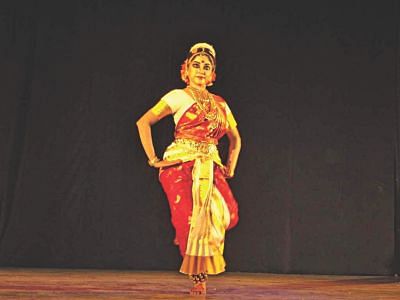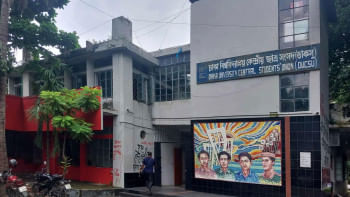Captivating minds with grace

Malabika Sen during the performance.
Dancing is more than just a form of art. It is a form of expression and a way of life. Portraying that in the most elegant manner, Malabika Sen enthralled the audience at the Bangladesh National Museum, Dhaka on October 5, 2012. Sen had visited Bangladesh numerous times before and has always left an impact with her graceful gestures, feather-like footwork, smooth transitions from one movement to the other, and effective expressions.
Sen is one of the leading exponents of Bharatanatyam and Kuchipudi dance forms in India at the moment. She had started training at the age of 6 and went on to complete her Masters in Dance from Prachin Kala Kendra University of Chandigarh in India. Since 1989, she has trained under legendary Indian dance guru, Dr. Thankamani Kutty, at Kalamandalam in Kolkata.
This time, Sen did a solo performance at the main auditorium of the National Museum. The show had started at 6:30 pm and ended at 7:30 pm. The performance included four Bharatanatyam pieces, and one Kuchipudi piece to end things on a different note. The first piece was “Ganapati Vandana”. This piece was performed to praise Lord Ganesha and to seek his blessings. Through this, the dancer also greeted and saluted the audience.
The second piece was a 'Padam' called “Krishna Nee Begane Baro”. This composition was performed to narrate the childhood and mischievousness of Lord Krishna. In this piece, Sen showed her versatility with graceful hand gestures and descriptive expressions -- making it easier for the viewers to understand the story behind the dance. The next piece was another 'Padam' called “Thaye Yashoda”. “Thaye Yashoda” is about the gopika (female cowherds) complaining to Yashoda (Krishna's mother) about Lord Krishna. The accompanying song has eight 'charanam' (stanzas) and each describes the pranks of Krishna in a humorous manner.
The last Bharatanatyam piece was “Dashavatara”, to the song “Jai Jagadish Harey”. The ten most famous incarnations of Krishna are collectively known as the 'Dashavatara'. The ten incarnations are: Matsya (the fish), Kurma (the tortoise), Varaha (the boar), Narasimha (the half man/half lion), Vamana (the dwarf), Parashurama (Rama with the axe), Rama (the prince and king of Ayodhya), Balarama, Buddha and Kalki (the destroyer of foulness). Each of these incarnations was depicted by Sen with utmost sincerity to the characters.
The last piece, which was a Kuchipudi composition, was “Keertana Tharakka”. In this final piece, Sen demonstrated her strengths and range by showing off her skills to the audience. The final couple of minutes of this piece were performed on a brass plate on which she performed a series of complicated steps.
Malabika Sen was accompanied by her guru, Dr. Thankamani Kutty, and her guru's son (the narrator who helped the audience understand each piece), Mohan Kutty.
Sen performed on October 6, 2012, at the Muslim Hall in Chittagong. She will perform today at the Shilpakala Academy in Rajshahi and on October 10 at the Town Hall in Rangpur.

 For all latest news, follow The Daily Star's Google News channel.
For all latest news, follow The Daily Star's Google News channel. 



Comments